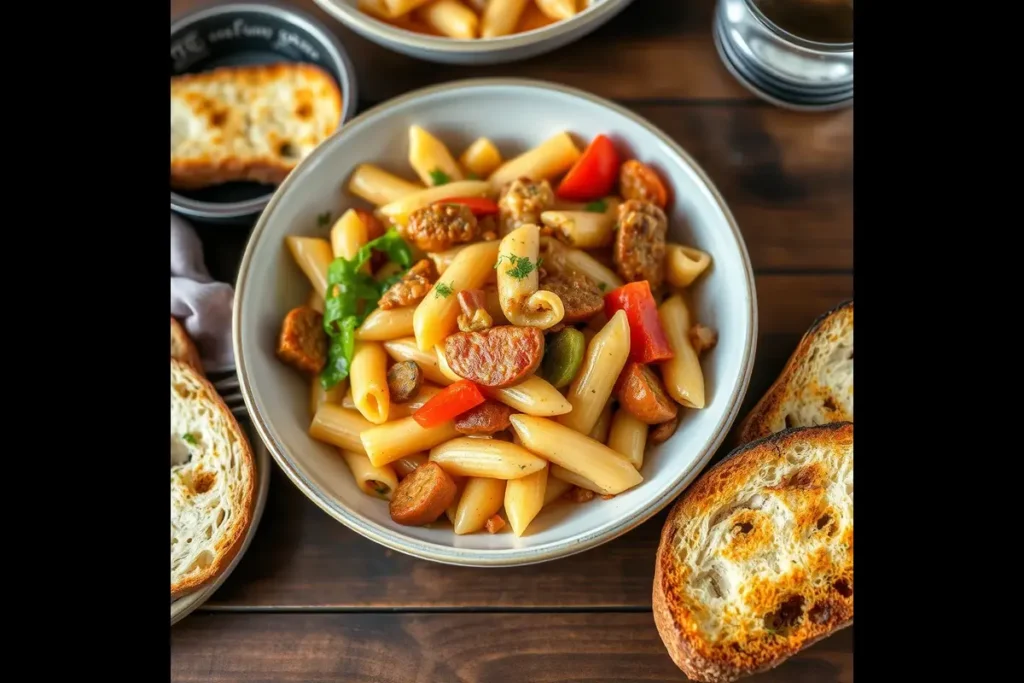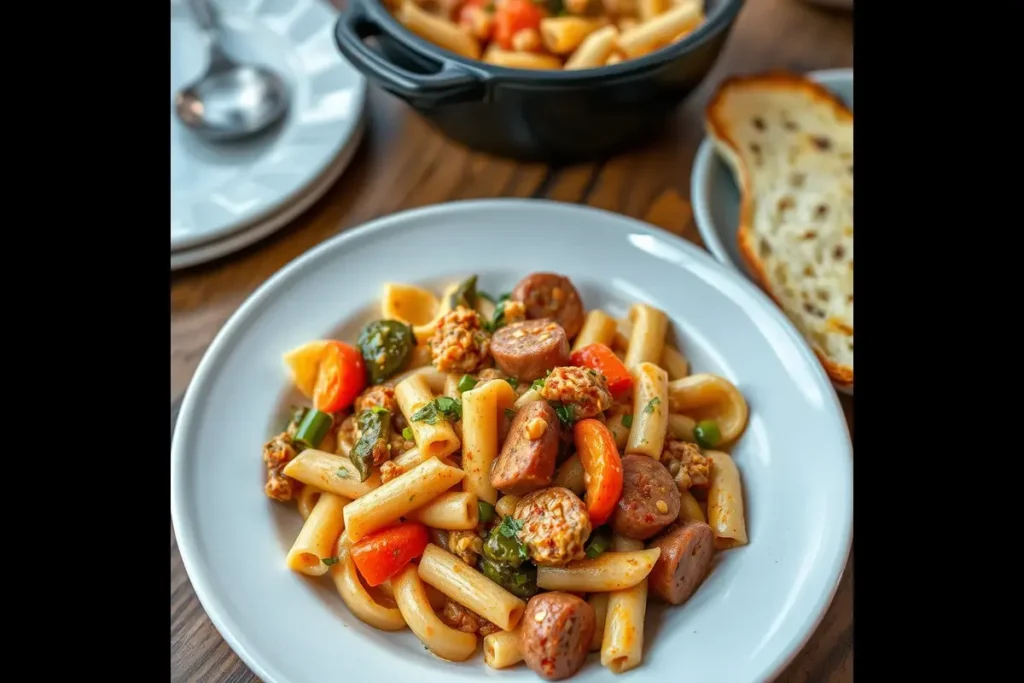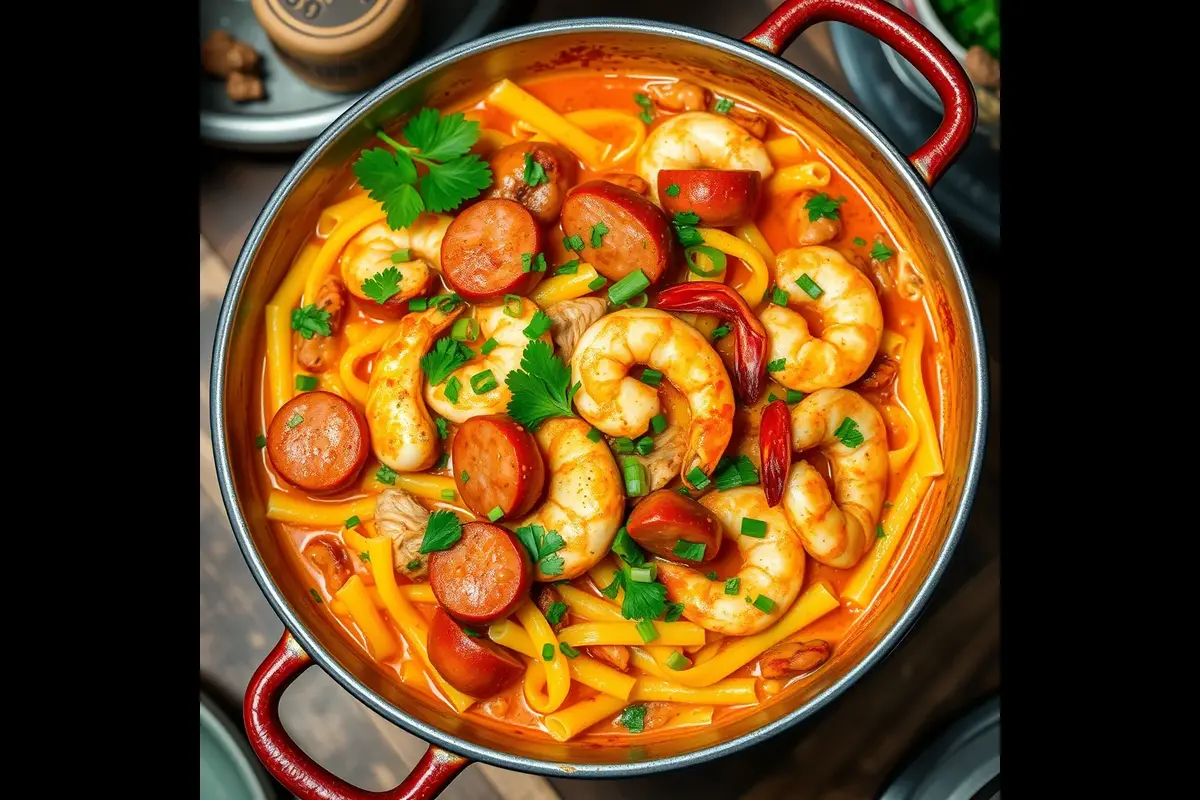Pasta and jambalaya lovers, rejoice! Pastalaya combines the rich, bold flavors of Cajun jambalaya with the comforting texture of pasta, creating a dish that’s perfect for family dinners, potlucks, or special gatherings. Originating in the heart of Louisiana, this dish brings together the savory goodness of sausage, chicken, and shrimp with a medley of vegetables and spices. Whether you’re new to Cajun cooking or already a fan, this recipe is bound to become a favorite in your household. Let’s dive into the world of pastalaya and discover how to prepare it like a pro!
What is Pastalaya?
A Cajun-Inspired Fusion
Pastalaya is a Louisiana-born dish that marries the flavors of traditional jambalaya with the versatility of pasta. While jambalaya uses rice as its base, pastalaya opts for pasta, giving the dish a slightly different texture but retaining all the bold spices and savory proteins. This adaptation has become a staple in Cajun and Creole kitchens, loved for its ability to feed a crowd while satisfying cravings for hearty, flavorful meals.
Why Choose Pasta Instead of Rice?
The substitution of pasta for rice in pastalaya isn’t just about convenience—it’s about creating something new and exciting. Pasta absorbs the rich broth and spices beautifully, offering a different mouthfeel that many find irresistible. Additionally, the use of pasta opens the door to a variety of shapes and sizes, allowing cooks to customize the dish to their liking. From penne to rotini, the possibilities are endless, making pastalaya a versatile dish that appeals to diverse palates.
History and Origin of Pastalaya
The Origin of Pastalaya
Pastalaya is a culinary innovation born out of Louisiana’s rich cultural heritage. Rooted in the classic jambalaya, a dish that has graced Cajun and Creole tables for centuries, pastalaya takes the same robust flavors and swaps rice for pasta. This evolution likely began as a way to modernize the dish and cater to broader tastes, making it a unique fusion of tradition and creativity.
Cajun and Creole cuisines are deeply influenced by the blending of French, Spanish, and African cooking traditions. Jambalaya itself draws inspiration from Spanish paella, with Creole recipes often incorporating tomatoes while Cajun versions do not. Pastalaya, however, transcends this divide, focusing on hearty proteins, bold seasonings, and a savory broth that pasta absorbs beautifully. It’s a dish that speaks to the resourcefulness and adaptability of Louisiana’s cooks.
Why Use Pasta Instead of Rice?
The choice to use pasta instead of rice is both practical and transformative. Pasta is faster to cook and more forgiving, making it a convenient option for busy cooks or large gatherings. Additionally, pasta’s texture is a game-changer—it absorbs the spices and broth while providing a firm bite that contrasts nicely with tender meats and vegetables. The variety of pasta shapes also allows for customization, from the ridged penne that clings to sauces to the twirled linguine that wraps around every flavorful bite.
Ingredients Breakdown
Essential Ingredients for a Traditional Pastalaya Recipe
Crafting the perfect pastalaya starts with choosing the right ingredients. Each component contributes to the dish’s complexity and depth, making it an explosion of flavor in every bite.
Proteins
The backbone of pastalaya is its rich assortment of proteins. Andouille sausage, with its smoky and spicy flavor, is a quintessential ingredient that embodies Cajun cooking. Chicken, particularly thighs, adds a tender and hearty element, while shrimp introduces a sweet and briny touch that balances the dish beautifully. Together, these proteins create a well-rounded base.
Vegetables
No pastalaya is complete without the “Holy Trinity” of Cajun cooking: onions, bell peppers, and celery. These vegetables form the aromatic foundation of the dish, infusing the broth with their natural sweetness and depth. Optional additions like diced tomatoes, garlic, or okra can enhance the flavor further, adding variety and texture.
Pasta
Pasta selection is key to achieving the perfect pastalaya. Short, sturdy pasta like penne or rigatoni works well, as it holds the sauce and doesn’t overcook easily. Linguine or fettuccine can also be used for a more elegant presentation. Whichever you choose, ensure the pasta is cooked al dente for the best texture.
Seasonings and Spices
The bold flavors of pastalaya come from its spices. Creole seasoning, with its mix of paprika, garlic powder, and herbs, sets the tone for the dish. Cayenne pepper adds a kick, while thyme and oregano bring earthy undertones. Smoked paprika enhances the dish’s depth, and a dash of salt and black pepper ties it all together.
Liquids
The liquids in pastalaya play a dual role: they cook the pasta and create the rich sauce that defines the dish. Chicken broth serves as the base, providing savory depth. Diced tomatoes contribute acidity and sweetness, while optional heavy cream adds a luxurious, velvety texture that balances the spices. Together, these liquids ensure the pasta absorbs all the bold flavors while maintaining a cohesive consistency.
Step-by-Step Cooking Instructions

Preparing Pastalaya
Cooking pastalaya is a step-by-step process that brings together bold flavors and comforting textures. Follow these detailed instructions for a dish that’s guaranteed to impress.
Step 1: Prepping the Ingredients
Preparation is key to ensuring a smooth cooking process. Begin by chopping the onions, bell peppers, and celery into uniform pieces to ensure even cooking. Slice the andouille sausage into bite-sized rounds, and cut the chicken into small, consistent pieces. Mince the garlic finely and measure out all your spices and seasonings. Having everything ready to go makes the cooking process seamless and efficient.
Step 2: Sautéing the Proteins
Heat a large, heavy-bottomed pot or Dutch oven over medium heat. Add a splash of oil and brown the sliced sausage, letting it caramelize for about 5 minutes. Remove the sausage and set it aside. In the same pot, add the chicken pieces, seasoning them lightly with salt and Creole seasoning. Cook for 7–8 minutes until golden and cooked through, then set aside with the sausage.
Step 3: Building the Flavor Base
Using the same pot, add a bit more oil if needed, then toss in the chopped onions, bell peppers, and celery. Sauté the vegetables for 5–7 minutes until softened and aromatic. Stir in the minced garlic and cook for an additional minute. Sprinkle the mixture with Creole seasoning, smoked paprika, cayenne pepper, and dried herbs, ensuring the spices coat the vegetables evenly. This forms the flavorful base of the dish.
Step 4: Adding Liquids and Pasta
Pour the chicken broth into the pot, deglazing any browned bits from the bottom to enhance the dish’s depth. Add the diced tomatoes and stir well. Bring the mixture to a gentle simmer, then add your pasta of choice. Stir frequently to ensure the pasta cooks evenly and absorbs the flavors of the broth and spices. This process usually takes 10–12 minutes, depending on the pasta type. Keep the heat at a steady simmer to avoid overcooking.
Step 5: Finishing Touches with Shrimp and Cream
Once the pasta is nearly al dente, stir in the shrimp. Let them cook for about 3–4 minutes until they turn pink and opaque. For a richer texture, add a splash of heavy cream and stir to combine. The creaminess balances the spices and gives the dish a velvety finish without overpowering the other flavors.
Step 6: Garnishing and Serving
Remove the pot from the heat and sprinkle chopped green onions and fresh parsley over the top. For an extra touch, add a light dusting of grated Parmesan cheese. Serve the pastalaya hot, and watch it disappear from plates in no time!
Variations and Substitutions
Customizing Your Pastalaya
One of the best things about pastalaya is its versatility. Whether you’re accommodating dietary preferences or experimenting with new flavors, this dish can be easily customized.
Vegetarian Pastalaya
For a plant-based version, swap the proteins with hearty vegetables like zucchini, mushrooms, and artichokes. Use plant-based sausage alternatives to replicate the smoky flavor of andouille. Vegetable broth can replace chicken broth, and an extra helping of herbs and spices ensures the dish remains flavorful.
Gluten-Free Options
To make pastalaya gluten-free, choose pasta made from rice, quinoa, or chickpeas. Ensure all seasonings and broths used are labeled gluten-free. A small amount of cornstarch or arrowroot mixed with water can thicken the sauce if needed, maintaining the dish’s signature consistency.
Seafood-Focused Pastalaya
Take the seafood element to the next level by incorporating crawfish, scallops, or crab meat along with shrimp. These additions add depth and luxury to the dish, perfect for special occasions. Pairing the seafood with a splash of lemon juice or white wine (non-alcoholic substitutes like lemon broth work, too) enhances the flavors beautifully.
Nutritional Insights
Health Benefits of Pastalaya
Pastalaya is not only delicious but also packed with nutrients that make it a satisfying and wholesome meal.
The inclusion of shrimp and chicken provides a high protein content essential for muscle repair and growth. Shrimp is also a great source of omega-3 fatty acids, which support heart health, while chicken offers lean protein and essential amino acids.
The vegetables in pastalaya, such as onions, bell peppers, and celery, contribute a variety of vitamins and minerals. These include vitamin C for immunity, vitamin A for eye health, and potassium for proper muscle function. Tomatoes add lycopene, a powerful antioxidant linked to reduced inflammation and improved heart health.
For those looking to reduce calories, consider modifying the recipe. Using a lighter cream alternative or omitting cream altogether can lower fat content. Replacing traditional pasta with whole-grain or gluten-free options increases fiber, promoting better digestion and prolonged satiety. By balancing the ingredients, pastalaya becomes a nutrient-dense meal that caters to diverse dietary needs.
Tips for the Perfect Pastalaya

Expert Tips for Flawless Results
To make the most of your pastalaya recipe, follow these tips to ensure a flavorful and well-balanced dish:
Balancing Spice Levels: Cajun and Creole seasonings define the dish, but their intensity can vary by brand. Start with smaller amounts and taste as you cook, adjusting the spice to match your heat preference. For a milder dish, reduce cayenne pepper or add a splash of cream to mellow the flavors.
Ensuring the Pasta Cooks Al Dente: Adding pasta directly to the simmering broth allows it to soak up the bold flavors, but timing is everything. Check frequently and remove from heat once the pasta is al dente to avoid a mushy texture.
How to Prevent the Dish from Becoming Too Watery or Dry: Use the right amount of liquid by carefully measuring chicken broth and other wet ingredients. If the dish becomes too watery, simmer uncovered for a few minutes to thicken. Conversely, if it’s too dry, add small amounts of broth or cream while stirring to achieve the desired consistency.
With these tips, your pastalaya will come out perfectly every time!
Serving Suggestions
What to Serve with Pastalaya
While pastalaya is a hearty and satisfying dish on its own, pairing it with the right sides and beverages can enhance the dining experience even further.
For sides, cornbread is a classic choice that adds a touch of sweetness and complements the bold, spicy flavors of pastalaya. A green salad with a light vinaigrette can provide a refreshing contrast to the richness of the dish, balancing the meal with a crisp and tangy element. Garlic bread is another fantastic option, offering a savory crunch and a great way to scoop up the flavorful sauce that coats the pasta.
When it comes to beverages, think about balancing the spice and savoriness of pastalaya. A glass of iced tea, whether sweetened or unsweetened, offers a cool and neutral accompaniment. For a non-alcoholic twist, a citrus spritzer or sparkling water with lime can refresh the palate between bites. Those who prefer bolder flavors might opt for a dark roast coffee or a spiced chai tea, which align with the earthy, smoky notes of Cajun cuisine.
With the right pairings, your pastalaya meal becomes a feast that celebrates the best of Louisiana’s vibrant culinary traditions.
Frequently Asked Questions (FAQs)
FAQs About Pastalaya
What’s the difference between jambalaya and pastalaya?
The primary difference lies in the starch base. Jambalaya uses rice, while pastalaya substitutes it with pasta. This simple swap changes the texture and how the dish absorbs the broth and seasonings. Both share similar Cajun flavors, combining proteins like sausage, chicken, and shrimp with bold spices, but pastalaya offers a twist for pasta lovers and a slightly different bite.
Can I make pastalaya ahead of time?
Yes, pastalaya can be prepared in advance, making it perfect for gatherings or meal prep. Cook the dish as instructed but stop just short of fully cooking the pasta. Store it in an airtight container in the refrigerator. When ready to serve, reheat gently on the stovetop with a splash of broth or cream to refresh the flavors and ensure the pasta doesn’t become overcooked.
What type of pasta works best in pastalaya?
Short, sturdy pasta like penne or rotini is ideal because it holds the sauce well and doesn’t break apart during cooking. Linguine or fettuccine can also be used for a more traditional presentation, but these may require more careful handling to prevent overcooking or clumping.
How do I store and reheat pastalaya?
To store, transfer cooled pastalaya into an airtight container and refrigerate for up to 3 days. For reheating, use a skillet or pot over medium heat, adding a splash of chicken broth or water to loosen the sauce and prevent sticking. Stir frequently and heat until warmed through for the best texture and flavor.
Conclusion
Why Pastalaya Should Be Your Next Go-To Recipe
Pastalaya is a versatile dish that combines the bold, comforting flavors of Cajun cuisine with the universal appeal of pasta. Its adaptability allows for endless variations, from seafood-focused creations to vegetarian-friendly versions, making it suitable for any occasion or dietary need.
Easy to prepare and packed with flavor, pastalaya brings the taste of Louisiana to your table in a way that’s both satisfying and crowd-pleasing. Whether you’re cooking for family, hosting a dinner party, or exploring new culinary adventures, this recipe is a guaranteed hit. So grab your ingredients, get cooking, and make pastalaya your next go-to comfort food!

